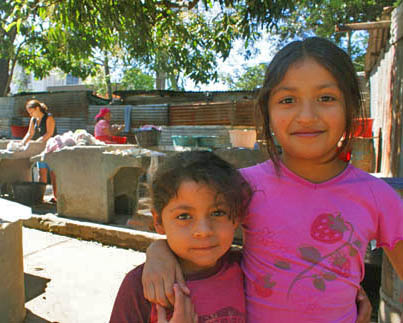

Building a “Big Apple” in the slums of San Salvador

For most people, “The Big Apple” conjures images of living the high life amidst New York City’s glamorous Fifth Avenue stores, the theaters on Broadway, the dizzying heights of the Empire State Building and the beacon of the Statue of Liberty.
For the residents of La Cruz, whose shanty-town outside El Salvador’s capital will shortly bear the same name, living in “the Big Apple” simply means they will no longer have to live in squalor, without indoor plumbing, electricity or drinking water, sharing a few public toilets and washrooms with 143 other families.
La Cruz is undergoing a dramatic transformation -- and a renaming as “La Gran Manzana” -- through an innovative United Nations programme financed by the MDG-Fund to help address El Salvador’s housing crisis and to provide basic services for its poorest residents.
La Cruz’s community leader, Felipe Henríquez, describes the extreme poverty and deprivation of La Cruz, which is surrounded by shops, public institutions and hospitals in the Santa Tecla neighborhood of San Salvador. "We’ve been suffering here for more than 30 years. How is it possible to live in the city and yet in the appalling conditions in which we live?”
"It's now or never," he remembers saying to himself just a year ago when, after touring La Cruz with a United Nations team, he was told that his community was eligible to participate in a new project that would transform the slum into a productive and sustainable urban settlement. "It was our ticket to the future," he says.
With just over 5.7 million people, El Salvador has a housing deficit of nearly half a million dwellings. In the San Salvador metropolitan area, which is home to a quarter of the country’s population, authorities have identified more than 1,700 “precarious” settlements that do not offer minimum basic services.
To help tackle the problem, the joint programme launched a national architectural contest last February under the heading "The Right to the City: The Big Apple" in order to create quality, affordable housing for the residents of La Cruz. The programme is also encouraging residents to offer services such as maintenance and construction to local businesses as a way to increase their incomes and connect them with the surrounding community.
The intervention was not a minute too soon. Life in the shanty-town is an ordeal, says Philip, who recalls when the community had to illegally hook into the electricity grid 15 years ago in order to get power. The dwellings still lack drinking water; the need to share sanitation and washing facilities produces enormous friction and conflicts break out regularly.
The Santa Tecla project is being financed through important agreements with the private sector. Beyond the social benefits it is bringing to La Cruz, it represents an innovative model to address the housing crisis in El Salvador that the authorities plan to replicate in other parts of the country.
In addition to new housing, the project is also building recreational, commercial and artistic facilities in order to raise living standards andintegrate the Big Apple into the economic development of the neighboring areas. Since its launch a few months ago, “La Gran Manzana” has received grants to help strengthen the community’s social fabric and to offer workshops and classes for women and children.
“It’s a dream come true," says Felipe Henriquez. "La Cruz has never felt so proud of itself.”
The joint program “Urban and Productive Integrated Sustainable Settlements in El Salvador” is being implemented by three UN agencies (UNDP, UNIDO and UN-Habitat) in collaboration with the Department of Housing and municipal authorities. It is part of the MDG-F’s work to help El Salvador achieve the Millennium Development Goals of eradicating extreme poverty and hunger, achieving gender equality and empowering women, and promoting environmental sustainability.